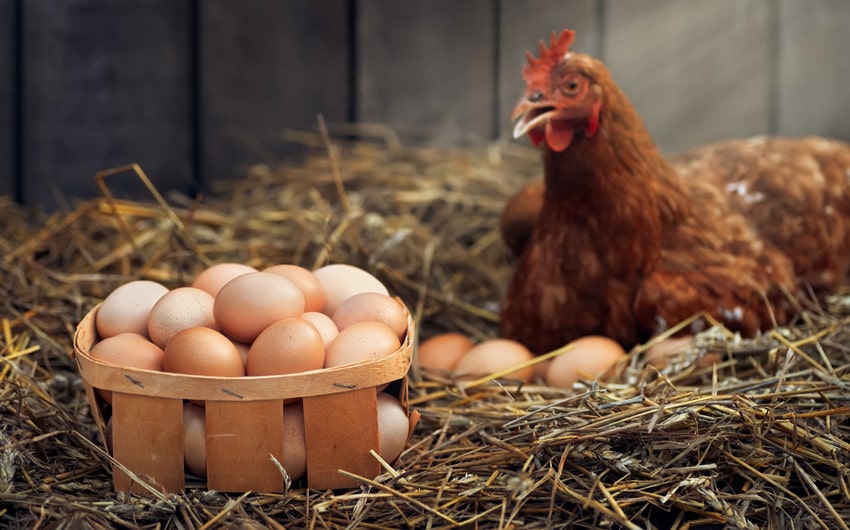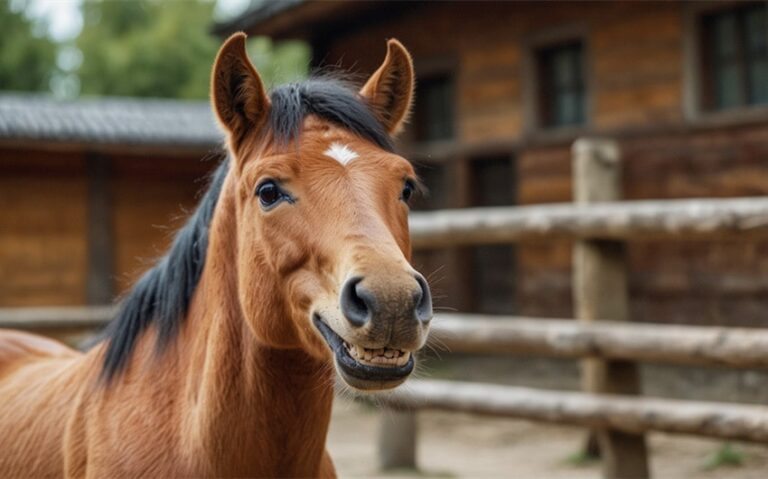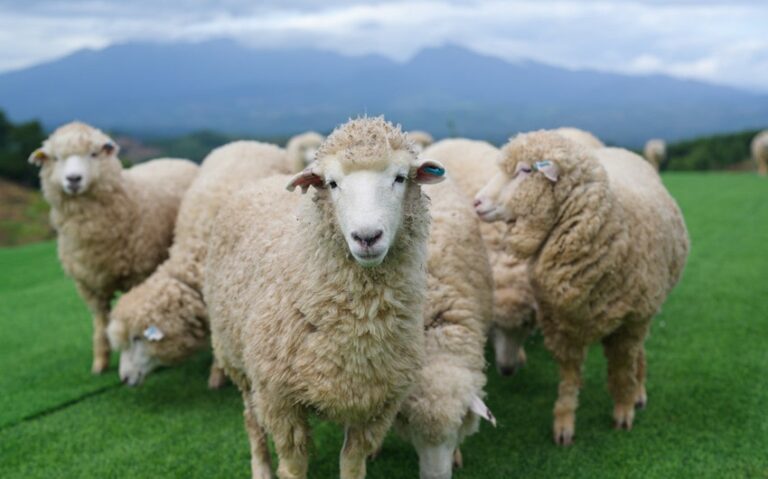Top 8 Best Egg Laying Chickens for High Egg Production
Choosing the best egg laying chickens for your backyard flock can make a significant difference in your egg supply. Whether you’re a seasoned poultry keeper or just starting, selecting the right breeds ensures you get plenty of fresh eggs all year round.
This article will guide you through the top breeds known for their high egg production, detailed profiles of each breed, and practical tips for managing and caring for your egg-laying hens. By understanding the unique characteristics and needs of these breeds, you can create a productive and healthy flock that consistently provides high-quality eggs.
Criteria for Selecting Egg Laying Chickens
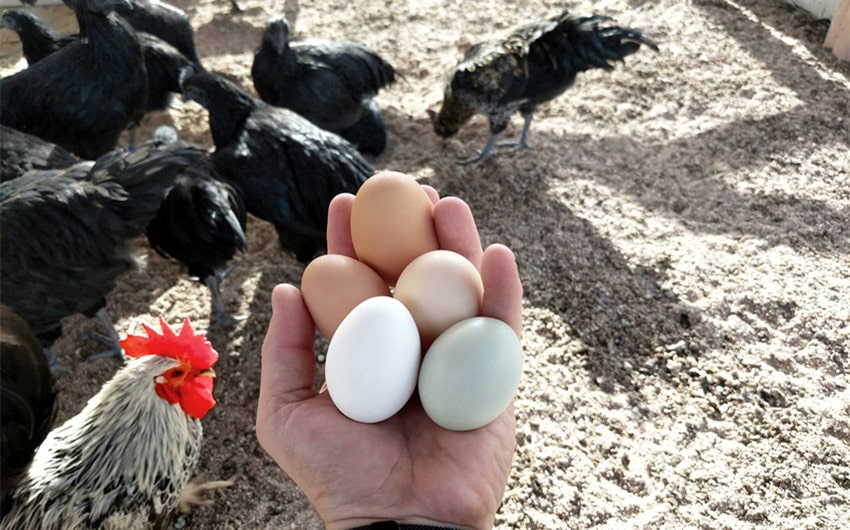
Choosing the best egg laying chickens involves a thoughtful consideration of several important factors. Each criterion plays a crucial role in ensuring you have a productive and manageable flock that meets your specific needs. Here are the key criteria to keep in mind:
Egg Production Rate
The primary reason for selecting egg laying chickens is their ability to produce a high number of eggs consistently. Different breeds have varying egg production rates. For example, Leghorns can lay up to 300 white eggs per year, making them one of the most prolific layers.
On the other hand, Rhode Island Reds are known for their ability to lay around 250 to 300 brown eggs annually. Choosing breeds with high egg production rates ensures a steady supply of eggs throughout the year.
Egg Size and Color
Egg size and color can be significant depending on your preferences or market demands. Some breeds, like the Leghorn, produce large white eggs, which are often preferred in commercial markets. Others, like the Sussex, lay medium to large brown eggs, which are popular in backyard flocks and farmers’ markets.
Additionally, breeds like the Ameraucana are known for their unique blue or green eggs, adding a colorful variety to your egg basket. Understanding the egg characteristics of different breeds helps you select chickens that meet your specific needs and preferences.
Temperament and Behavior
The temperament and behavior of the chickens are crucial, especially if you are keeping them in a backyard setting or around children. Breeds like the Orpington and Australorp are known for their calm, friendly, and docile nature, making them ideal for families and first-time chicken keepers.
Conversely, breeds like the Leghorn are more active and flighty, which might be better suited for more experienced handlers. Choosing breeds with a temperament that suits your environment and handling capabilities ensures a harmonious and enjoyable experience with your flock.
Climate Adaptability
Chickens need to thrive in your local climate to be productive. Some breeds are better suited to cold climates and can withstand harsh winters, while others are more comfortable in hot and humid conditions. For instance, Brahmas and Australorps are known for their cold hardiness, making them suitable for northern climates.
In contrast, breeds like the Leghorn and Ancona are more heat-tolerant and perform well in warmer regions. Researching the climate adaptability of different breeds ensures they can handle the weather in your area, minimizing stress and health issues.
Health and Hardiness
Healthy and hardy chickens are less likely to succumb to diseases and environmental stresses. Breeds like the Rhode Island Red and Plymouth Rock are known for their robust health and hardiness, requiring minimal medical interventions.
These breeds have a good track record of resistance to common poultry diseases and pests, ensuring a more resilient flock. Selecting hardy breeds reduces the likelihood of health issues and ensures a more productive and long-lived flock.
Feed Efficiency
Efficient conversion of feed into eggs is another critical factor. Some breeds are more efficient in their feed consumption, producing more eggs with less feed. For example, Leghorns are known for their excellent feed-to-egg conversion ratio, making them cost-effective for egg production.
Understanding the feed efficiency of different breeds helps you manage costs and ensure your chickens are well-nourished, maximizing their egg-laying potential.
Broodiness
Broodiness refers to a hen’s tendency to sit on eggs to hatch them rather than continuing to lay new ones. While this can be desirable if you want to hatch chicks, it can reduce overall egg production. Breeds like the Leghorn and Ancona are known for their low broodiness, focusing more on continuous egg laying.
On the other hand, breeds like the Sussex and Orpington have a higher tendency towards broodiness, which can be beneficial if you plan to expand your flock naturally. If your primary goal is egg production, selecting breeds with low broodiness is advisable.
Lifespan and Longevity
The lifespan and longevity of the chickens can impact how long they will be productive layers. Some breeds have longer productive lifespans than others.
For example, Australorps are known for their extended laying periods, often producing eggs consistently for several years. While most chickens will slow down in egg production as they age, choosing breeds known for their extended laying periods ensures a longer duration of high egg output.
Availability and Cost
Finally, consider the availability and cost of the breeds you are interested in. Some breeds might be more readily available and affordable, such as the Rhode Island Red and Leghorn. In contrast, rare breeds like the Ameraucana or certain heritage breeds can be more expensive and harder to find.
Balancing the initial cost with the long-term benefits of high egg production is essential for making a cost-effective decision. It may also be worthwhile to connect with local breeders or poultry associations to find the best options available in your region.
Top Egg Laying Chicken Breeds: Detailed Profiles
Selecting the best egg laying chickens involves understanding the unique characteristics and capabilities of each breed. Here are the top breeds known for their exceptional egg-laying abilities, with detailed profiles to help you make an informed decision:
1. Leghorn
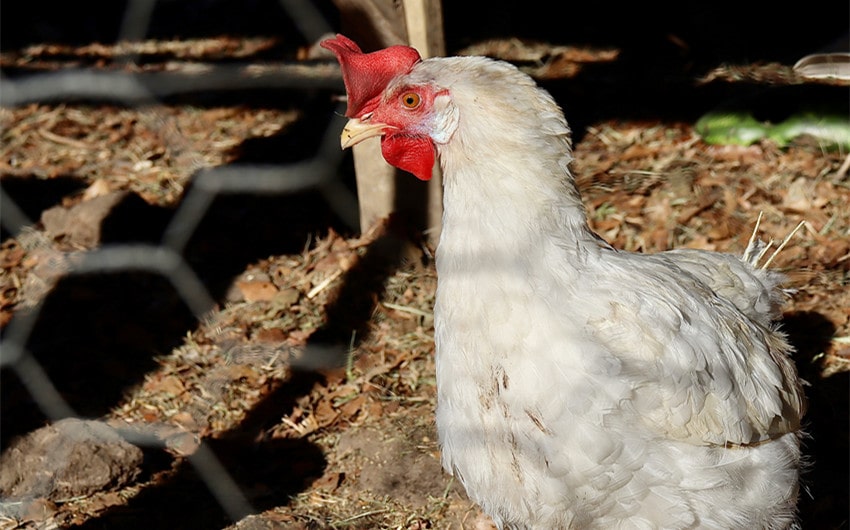
Origin and History
Leghorns originated from Italy and were brought to the United States in the early 19th century. They quickly gained popularity for their prolific egg-laying abilities.
Physical Characteristics
Leghorns are relatively small and lightweight, usually weighing between 4 to 6 pounds. They have white feathers and a prominent single comb, contributing to their high energy and active nature.
Egg Production
Leghorns can lay up to 300 large white eggs per year. They begin laying at a young age and maintain consistent productivity.
Temperament
Leghorns are active and alert birds. They can be flighty and prefer to free-range, making them less suitable for confined spaces. However, they are hardy and require minimal maintenance.
2. Rhode Island Red

Image source: Pinterest
Origin and History
Developed in the United States in the late 19th century, Rhode Island Reds were created by crossing local birds with imported breeds such as the Malay and Leghorn to enhance egg production and hardiness.
Physical Characteristics
Medium to large birds, with roosters weighing around 8.5 pounds and hens about 6.5 pounds. They have rich, dark red feathers and a sturdy build.
Egg Production
Rhode Island Reds are prolific layers, producing between 250 to 300 large brown eggs per year. They are reliable layers even in less-than-ideal conditions.
Temperament
Friendly and docile, making them suitable for backyard flocks and family environments. They are also excellent foragers and can thrive in free-range conditions.
3. Plymouth Rock

Image source: Pinterest
Origin and History
One of the oldest and most established breeds in the United States, Plymouth Rocks were first recognized in the late 19th century.
Physical Characteristics
Large birds, with roosters weighing around 9.5 pounds and hens about 7.5 pounds. They have a distinctive black and white barred feather pattern and a single comb.
Egg Production
Steady layers, producing around 200 to 280 large brown eggs per year. They can lay well into the winter months.
Temperament
Friendly and calm, making them ideal for families and beginners. They are hardy and adaptable to various climates.
4. Australorp
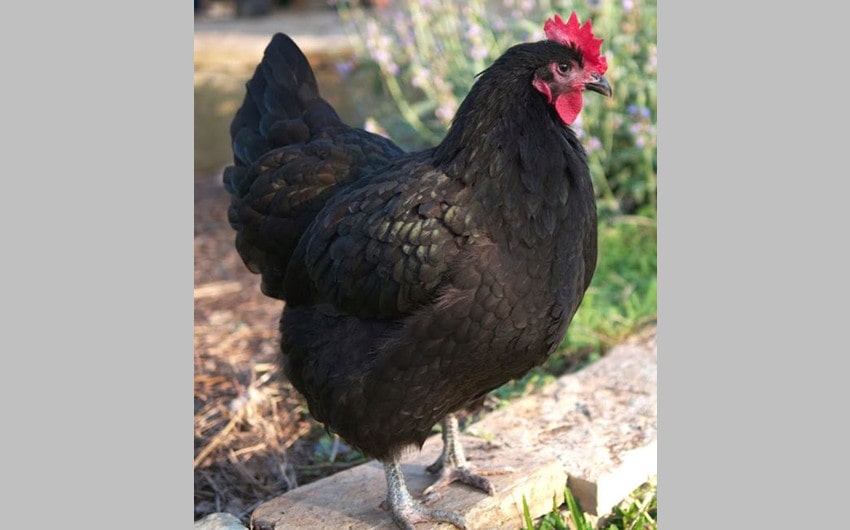
Image source: Pinterest
Origin and History
Developed in Australia in the early 20th century, Australorps are derived from the Orpington breed and were selectively bred for their egg-laying abilities.
Physical Characteristics
Medium to large birds, with roosters weighing around 8.5 pounds and hens about 6.5 pounds. They have shiny black feathers with a greenish sheen.
Egg Production
Capable of laying up to 250 to 300 large brown eggs per year, with some records showing over 300 eggs in a single year.
Temperament
Calm, friendly, and easy to handle. Their gentle disposition makes them suitable for families and novice poultry keepers.
5. Sussex
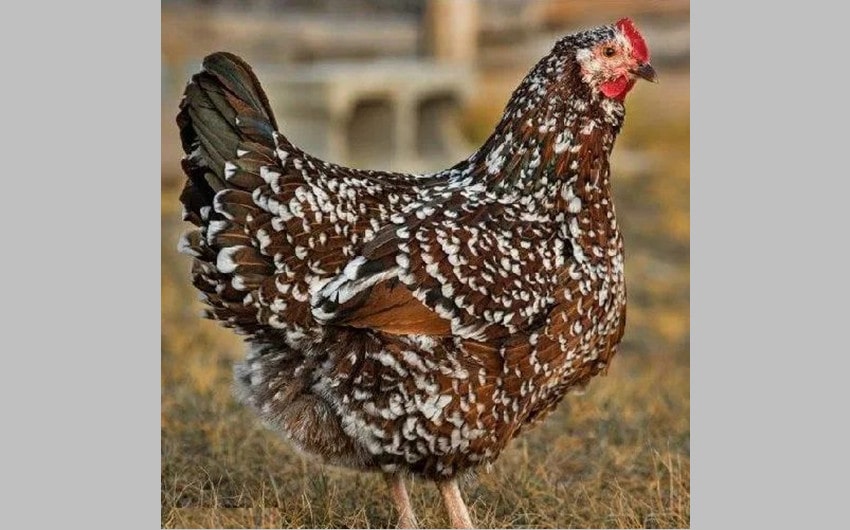
Image source: Pinterest
Origin and History
Originating in England, the Sussex breed is one of the oldest known chicken breeds, dating back to the Roman era.
Physical Characteristics
Medium to large birds, with roosters weighing around 9 pounds and hens about 7 pounds. They come in several color varieties, including speckled, light, and red.
Egg Production
Consistent layers, producing between 200 to 250 large brown eggs per year.
Temperament
Calm, friendly, and curious by nature. They are easy to handle and make excellent pets, with hardy adaptability to various climates.
6. Ancona
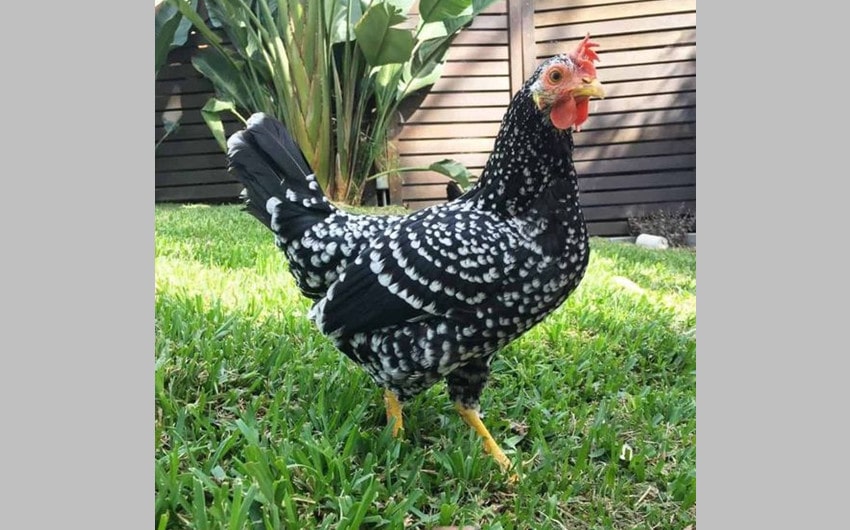
Image source: Pinterest
Origin and History
Originating from Italy and brought to England in the late 19th century, Anconas are named after the Italian city of Ancona.
Physical Characteristics
Medium-sized birds, with roosters weighing around 6 pounds and hens about 4.5 pounds. They have mottled black and white feathers.
Egg Production
Excellent layers, capable of producing up to 250 large white eggs per year, maintaining high productivity even in winter months.
Temperament
Active and hardy, with excellent foraging abilities. They are robust and easy to care for, making them a great choice for experienced keepers.
7. ISA Brown
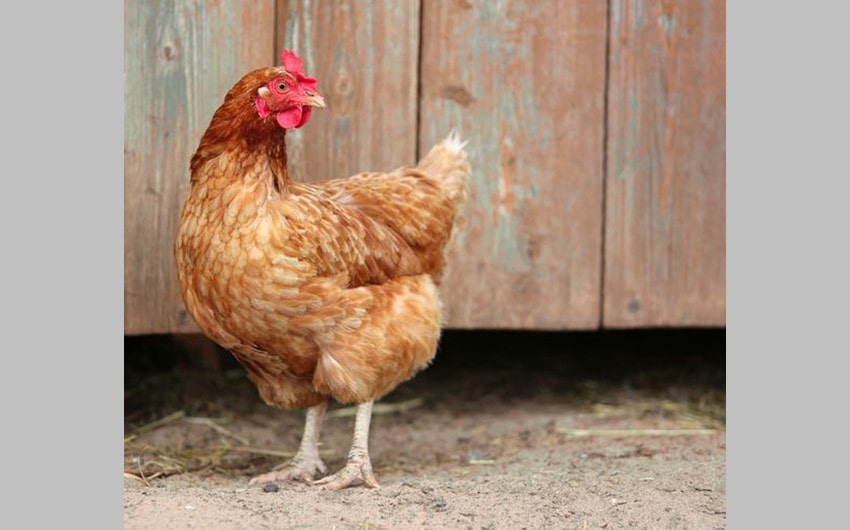
Image source: Pinterest
Origin and History
A modern hybrid breed developed specifically for high egg production by the Institut de Sélection Animale (ISA) in France.
Physical Characteristics
Medium-sized birds, with roosters weighing around 6.5 pounds and hens about 5.5 pounds. They have reddish-brown feathers.
Egg Production
Among the most prolific layers, capable of producing up to 300 large brown eggs per year.
Temperament
Friendly and easy-going. Their consistent laying and gentle nature make them ideal for both beginners and experienced poultry keepers.
8. Golden Comet
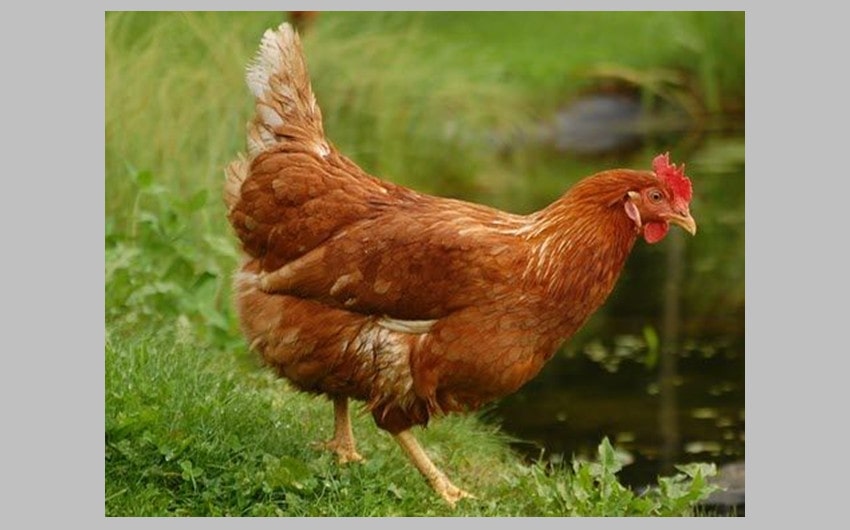
Image source: Pinterest
Origin and History
A hybrid breed created by crossing a Rhode Island Red with a White Leghorn, developed for prolific egg production.
Physical Characteristics
Medium-sized birds, with roosters weighing around 6 pounds and hens about 4.5 pounds. They have golden-red plumage.
Egg Production
Can lay between 250 to 300 large brown eggs per year, starting at a young age and maintaining high productivity.
Temperament
Friendly, docile, and easy to handle. Adaptable to various living conditions, suitable for both free-range and confined environments.
FAQ: Managing and Caring for Egg Laying Chickens

1. How often should I feed my egg laying chickens?
Feed your egg laying chickens daily with a high-quality layer feed that contains around 16-18% protein. Ensure they have constant access to fresh water and consider supplementing their diet with kitchen scraps, vegetables, and grains. Provide additional calcium sources like crushed oyster shells or limestone.
2. What should I include in a chicken coop for egg laying hens?
A well-designed coop for egg laying hens should have:
- At least 4 square feet of space per chicken.
- Proper ventilation to prevent respiratory issues.
- Secure nesting boxes (one for every 3-4 hens) lined with soft bedding.
- Perches or roosting bars with 8-10 inches of space per chicken.
- Protection from predators and harsh weather conditions.
3. How can I prevent my chickens from getting parasites?
Regularly check your chickens for external parasites like mites and lice, and use appropriate treatments if needed. Maintain clean living conditions by frequently replacing bedding and removing droppings. For internal parasites, consider routine deworming treatments. Quarantine new birds for at least 30 days before introducing them to your flock.
4. What are the signs of a healthy laying hen?
Healthy laying hens are active and alert, with bright eyes, clean feathers, and a good appetite. Their combs and wattles should be red and firm, and they should lay eggs consistently. Regularly check for signs of illness such as lethargy, changes in appetite, respiratory problems, or abnormal droppings.
5. How can I keep my chickens comfortable during extreme weather?
- Winter Care: Insulate the coop, protect it from drafts, and provide extra bedding for warmth. Use a heated waterer to prevent freezing.
- Summer Care: Provide ample shade and fresh water to keep chickens cool. Use fans or misters if necessary to reduce heat stress.
6. How do I introduce new chickens to my existing flock?
Quarantine new birds for at least 30 days to monitor for signs of illness and prevent the spread of disease. After the quarantine period, introduce new chickens gradually by placing them in a separate but adjacent area where they can see and interact with the existing flock without direct contact. Slowly integrate them over a few days to a week.
7. What can I do to maximize egg production in my hens?
To maximize egg production, ensure your hens receive a balanced diet with adequate protein and calcium, provide a clean and stress-free environment, and maintain regular health checks and parasite control. Consistent light exposure, about 14-16 hours a day, can also help maintain egg production, especially during shorter daylight periods.
8. Why are my hens not laying eggs consistently?
Inconsistent egg laying can result from various factors, including poor nutrition, stress, illness, inadequate lighting, or environmental changes. Ensure your hens have a balanced diet, a comfortable and secure living environment, and access to consistent light. Regularly check for signs of health issues and address them promptly.

